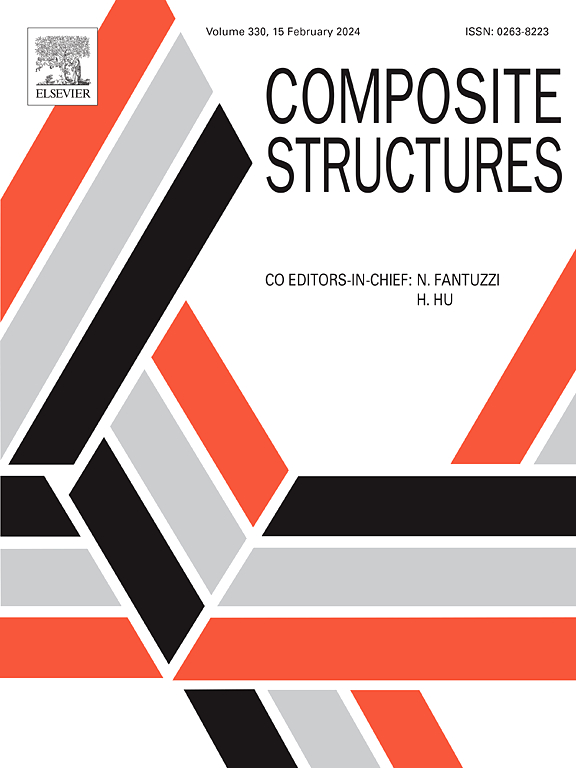使用粘合剂的偏移-计量回流复合材料粘合方法,可减轻严格的烧结表面公差
IF 6.3
2区 材料科学
Q1 MATERIALS SCIENCE, COMPOSITES
引用次数: 0
摘要
粘合剂固有的易受微量污染物影响的特性会导致难以察觉的粘合力减弱。因此,美国联邦航空管理局 (FAA) 对飞机主要结构中的粘接接头做出了严格规定。为了满足认证要求,飞机制造商采用了紧固件形式的冗余载荷路径,这必然会增加结构的重量并延长制造时间。在之前的工作中,开发了一种名为 AERoBOND 的二次粘接技术,该技术利用非计量环氧基质树脂来促进二次粘接/固化过程中树脂在接头界面内的回流和扩散,从而实现类似于共固化接头的粘接效果。然而,AERoBOND 工艺要求被连接的两个部件之间具有严格的空间公差。本研究考察了传统粘合剂与 AERoBOND 方法的结合使用情况,AERoBOND 方法可作为连接线中的填充物,有效降低对连接部件严格公差的要求,并可作为现有制造工艺的灵活替代方案。通过超声波检测、光学显微镜和 ASTM 国际标准测试,分析了接合处的缺陷,并量化了拟议方法在不同制造参数下的模式 I 和模式 II 层间断裂韧性和短梁强度。综合结果表明,当在压力为 791 kPa 的高压釜中进行二次固化时,有表面处理和无表面处理的 AERoBOND+ 方法与共固化和传统粘接接头的性能相当。例如,在 791 kPa 压力下粘接的未进行表面预处理的 AERoBOND+ 面板(本文中称为 AB+3),在粘合剂与预浸料界面处,未预开裂状态下的 I 型断裂韧性(GIc)为 0.643 kJ/m2,II 型断裂韧性(GIIc)为 4.000 kJ/m2,预开裂状态下为 4.218 kJ/m2。这些结果分别是共固化基线面板(本文中称为 C1)的 96%、142% 和 217%。本文章由计算机程序翻译,如有差异,请以英文原文为准。
Offset-stoichiometric reflowable composite bonding method with adhesive for mitigating strict faying surface tolerances
Inherent susceptibility of adhesive bonds to miniscule quantities of contamination can cause undetectable weakened bonds. For this reason, the Federal Aviation Administration (FAA) places strict regulations on adhesively bonded joints in primary aircraft structures. To meet certification requirements aircraft manufactures resort to redundant load paths in the form of fasteners which inherently add weight to the structure and increase manufacturing time. In prior work, a secondary bonding technique called AERoBOND was developed, which utilized off-stoichiometric epoxy-matrix resins to facilitate reflow and diffusion of the resin within the joint interface during a secondary bonding/cure process, thus achieving a bond similar to a co-cured joint. However, the AERoBOND process required tight spatial tolerances between the two parts being joined. This study examined the utilization of conventional adhesive with the AERoBOND method to act as a filler in the joint line, effectively reducing the need for tight tolerances on the joining parts and serving as a flexible alternative for existing manufacturing processes. Ultrasonic inspection, optical microscopy, and ASTM International standard tests were performed to analyze the joints for defects and to quantify the mode-I and mode-II interlaminar fracture toughness and short beam strength of the proposed methodology with varying manufacturing parameters. The comprehensive results indicate that the AERoBOND+ method with and without surface preparation performs comparably to co-cured and conventional, adhesively bonded joints when secondary cured in an autoclave with 791 kPa of pressure. As an example, the AERoBOND+ panel without surface preparation bonded with 791 kPa of pressure (referred to as AB+3 throughout paper) had a mode-I fracture toughness (GIc) of 0.643 kJ/m2 and a mode-II fracture toughness (GIIc) of 4.000 kJ/m2 in the non-precracked condition and 4.218 kJ/m2 in the precracked condition at the adhesive-to-prepreg interface. These results were 96 %, 142 %, and 217 %, respectively, of a co-cured baseline panel (referred to as C1 throughout paper).
求助全文
通过发布文献求助,成功后即可免费获取论文全文。
去求助
来源期刊

Composite Structures
工程技术-材料科学:复合
CiteScore
12.00
自引率
12.70%
发文量
1246
审稿时长
78 days
期刊介绍:
The past few decades have seen outstanding advances in the use of composite materials in structural applications. There can be little doubt that, within engineering circles, composites have revolutionised traditional design concepts and made possible an unparalleled range of new and exciting possibilities as viable materials for construction. Composite Structures, an International Journal, disseminates knowledge between users, manufacturers, designers and researchers involved in structures or structural components manufactured using composite materials.
The journal publishes papers which contribute to knowledge in the use of composite materials in engineering structures. Papers deal with design, research and development studies, experimental investigations, theoretical analysis and fabrication techniques relevant to the application of composites in load-bearing components for assemblies, ranging from individual components such as plates and shells to complete composite structures.
 求助内容:
求助内容: 应助结果提醒方式:
应助结果提醒方式:


